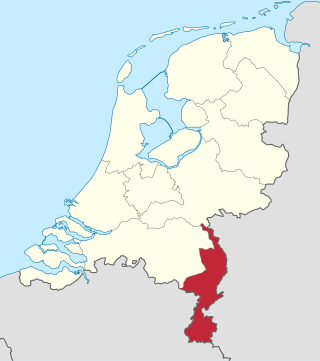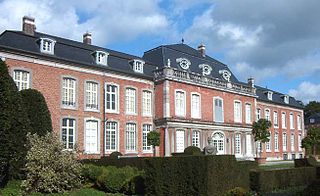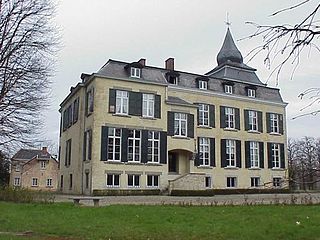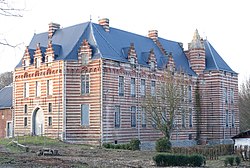
Limburg, also known as Dutch Limburg, is the southernmost of the twelve provinces of the Netherlands. It is bordered by Gelderland to the north and by North Brabant to its west. Its long eastern boundary forms the international border with the state of North Rhine-Westphalia in Germany. To the west is the international border with the similarly named Belgian province of Limburg, part of which is delineated by the river Meuse. To the south, Limburg is bordered by the Belgian province of Liège. The Vaalserberg is on the extreme southeastern point, marking the tripoint of the Netherlands, Germany and Belgium.

Limburg, also known as Belgian Limburg, is a province in Belgium. It is the easternmost of the five Dutch-speaking provinces that together form the Region of Flanders, which is one of the three main political and cultural sub-divisions of modern-day Belgium. As of January 2024, Limburg had a population of 0.9 million.

The Seventeen Provinces were the Imperial states of the Habsburg Netherlands in the 16th century. They roughly covered the Low Countries, i.e., what is now the Netherlands, Belgium, Luxembourg, and most of the French departments of Nord and Pas-de-Calais (Artois). Also within this area were semi-independent fiefdoms, mainly ecclesiastical ones, such as Liège, Cambrai and Stavelot-Malmedy.

Heerlen is a city and a municipality in the southeast of the Netherlands. It is the third largest settlement proper in the province of Limburg. Measured as municipality, it is the fourth municipality in the province of Limburg.

Wemmel is a municipality in the province of Flemish Brabant, in the Flemish region of Belgium. The municipality only comprises the town of Wemmel proper. On January 1, 2018, Wemmel had a total population of 16,347. The total area is 8.74 km2 (3.37 sq mi), which gives a population density of 1,870/km2 (4,800/sq mi).

Voeren is a Flemish Dutch-speaking municipality with facilities for the French-speaking minority, located in the Belgian province of Limburg. Bordering the Netherlands to the north and the Wallonia region's Liège Province to the south, it is geographically detached from the rest of Flanders, making Voeren an exclave of Flanders. Voeren's name is derived from that of a small right-bank tributary of the Meuse, the Voer, which flows through the municipality.

Arlon is a city and municipality of Wallonia, and the capital of the province of Luxembourg in the Ardennes, Belgium. With a population of just over 28,000, it is the smallest provincial capital in Belgium. Arlon is also the capital of its cultural region: the Arelerland.

Kessenich is a village in the Belgian province Limburg. It is a section of the municipality of Kinrooi, lying in the eastern end of the municipality.

The Duchy of Limburg or Limbourg was an imperial estate of the Holy Roman Empire. Much of the area of the duchy is today located within Liège Province of Belgium, with a small portion in the municipality of Voeren, an exclave of the neighbouring Limburg Province. Its chief town was Limbourg-sur-Vesdre, in today's Liège Province.

Horn is a village in the Dutch province of Limburg. It is a part of the municipality of Leudal, and lies about 5 km northwest of Roermond.

The Province of Brabant was a province in Belgium from 1830 to 1995. It was created in 1815 as South Brabant, part of the United Kingdom of the Netherlands. In 1995, it was split into the Dutch-speaking Flemish Brabant, the French-speaking Walloon Brabant and the bilingual Brussels-Capital Region.

The Castle de Renesse is a castle located in the village of Oostmalle (Malle), in the Campine region of the province of Antwerp. It is currently owned by the municipality of Malle.

The House of Limburg-Stirum, which adopted its name in the 12th century from the immediate county of Limburg an der Lenne in what is now Germany, is one of the oldest families in Europe. It is the eldest and only surviving branch of the House of Berg, which was among the most powerful dynasties in the region of the lower Rhine during the Middle Ages. Some historians link them to an even older dynasty, the Ezzonen, going back to the 9th century.

Diepenbeek Castle is a castle in Diepenbeek near Hasselt in the province of Limburg, Belgium. The building consists of a 15th-century keep with a 17th-century main block. It was once the establishment of the steward of the nearby Commandery of Alden Biesen, whence the alternative name.

Gors Castle is a 19th-century country house, in Gors-Opleeuw in the municipality of Borgloon, province of Limburg, Belgium.

Hamal Castle is a castle in Rutten near Tongeren in the province of Limburg, Belgium, once the centre of the small independent lordship of Rutten. The castle was first mentioned in 1214. The current castle dates from the late 18th century.

Hasselbroek Castle, also Hasselbrouck Castle is a 17th-century country house in Hasselbroek, in Jeuk, a part of the municipality of Gingelom, province of Limburg, Belgium.

Heks Castle is a château in the village of Heks in the municipality of Heers, province of Limburg, Belgium.

Ommerstein Castle is a castle in the village of Rotem in the municipality of Dilsen-Stokkem, province of Limburg, Belgium.

Herkenrode Abbey was a Catholic monastery of Cistercian nuns located in Kuringen, part of the municipality of Hasselt, which lies in the province of Limburg, Belgium.


























